In Addition
Vol 14 Ausgabe 5
September / October 2023
1. Health article
Flours for health and flavour!
“We are partaking of a variety of items as food to sustain the human body. But none is making an enquiry whether the food one consumes is proper and healthy; whether it is beneficial for nourishing and nurturing his physical, mental and spiritual health.”…Sathya Sai Baba1
Prelude: In the series ‘Avoiding unhealthy whites’, we considered the pros and cons of milk, sugar. salt, and rice, their varieties and alternatives, in the preceding three issues of vol 14. “Knowledge is flour, but wisdom is bread”.2 Let us now delve into the world of flours to gain wisdom to make healthy breads, porridges, puddings, desserts, and sauces!
1. What is flour?
Flour is a powder made by grinding raw grains, nuts, seeds, legumes, roots, or a fruit e g, coconut.
2. Dietary guide for flours
2.1 American dietary guidelines recommend for adults 1600 to 3000 calories/day based on their age, gender, weight, medical condition, and lifestyle. They also suggest an optimal proportion of each of the three macronutrients in the diet namely, carbs 45-65%, fats 20-35%, and protein 10-35%.3-5
2.2 Carb is indispensable: Carb consisting of simple sugar, starch, and fibre is the main source of fuel for the body. Fruits, vegetables, whole grains, nuts, and seeds all contain carbs essential for optimal digestive health, balancing sugar, protecting against disease, and weight control. Whole grains due to their fibre content have a low Glycaemic index (GI) but it goes up the moment a grain is ground into flour e g, whole wheat has a GI of 30 but its flour has a GI of 70. There are flours with low GI and low carbs e g, flours made from nuts, seeds, and other plant sources.5,6
2.3 GI range of flours: Almond, walnut, and ground flaxseed have zero GI and low carbs with high levels of good fat. Flours with low GI up to 50 are of nuts and seeds, soy, chickpeas, oat, and coconut; those having GI in the medium range above 50 are of quinoa, corn/maize, wholewheat, semolina, brown rice, barley, spelt, sorghum, tapioca, and arrowroot. High GI of 70 and above include white/all-purpose flour (maida) and flours of white rice, rye, millets, and amaranth. Almost all flours except refined ones are rich in fibre and protein.6-8 Refer to previous newsletters for a detailed nutritional profile of rice (vol 14 #4), other whole grains (vol 12 #5), nuts (vol 11 #1), seeds (vol 4 #6), and pulses (vol 13 #1).
2.4 Gluten is a protein inherent in wheat, barley and rye. Most other flours are naturally gluten-free but can be cross-contaminated with gluten during harvesting or processing, esp. in case of oats grown or processed near or in the same facility. Gluten gives dough its stretchy quality and structure otherwise it can rip easily. Gluten, especially in whole grains, is good for healthy people but should be avoided by people with celiac disease; it may not suit those with deficient small intestine or poor digestive system.9,10
2.5 Bran is the hard outer layer of whole grains, mostly found in wheat, barley, rye, rice, oat, millets, and corn. It is a good source of fibre, antioxidants, minerals, and vitamins. Wheat bran has insoluble and prebiotic fibre that stimulates the growth of healthy bacteria and prevents constipation; oats and barley bran have both soluble and insoluble fibre considered good for heart and to prevent sugar spikes. But bran has antinutrients and may not suit people with irritable bowel syndrome.11-13
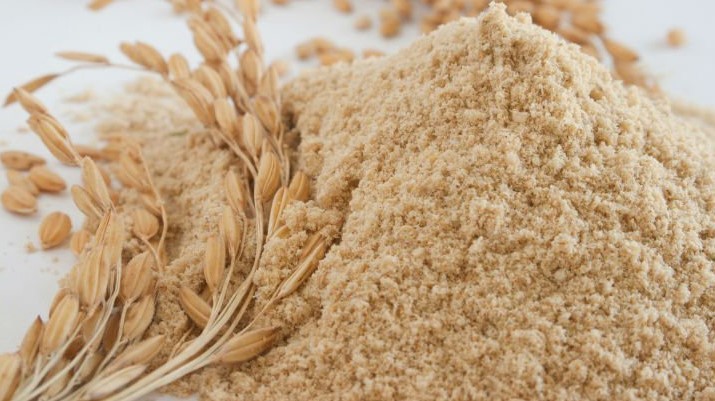
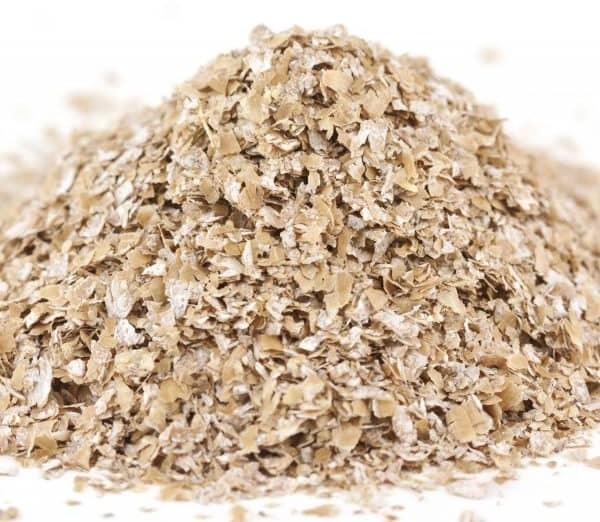
3. Various flours
3.1 Flours from grains containing gluten
There are different types of wheat flour, depending upon their gluten content. Whole wheat flour (aata), rich in fibre and nutrients, and carb rich semolina (suji) from durum wheat, the most common flours with 13-14% gluten; all-purpose flour (maida) with 12% gluten, its another version is self-rising flour containing baking powder and salt; pastry flour with 9-10% gluten; soft cake flour with 7.5 to 9% gluten. Some of these are mixed to create different textures and better rising while baking.14-16
Barley flour, higher in dietary fibre than wheat, contains 5-8% gluten. The more nutritious rye flour contains only 3% gluten.17-18
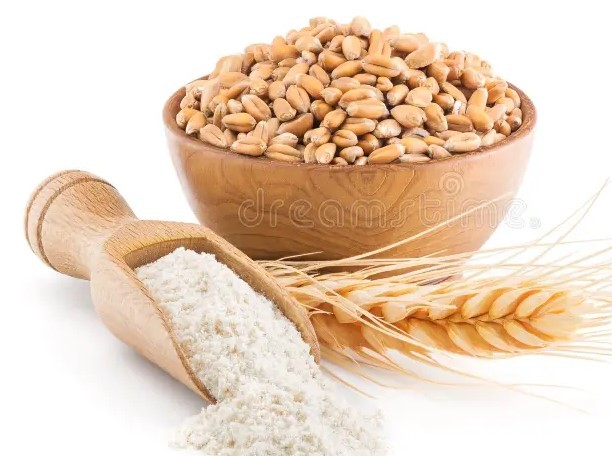
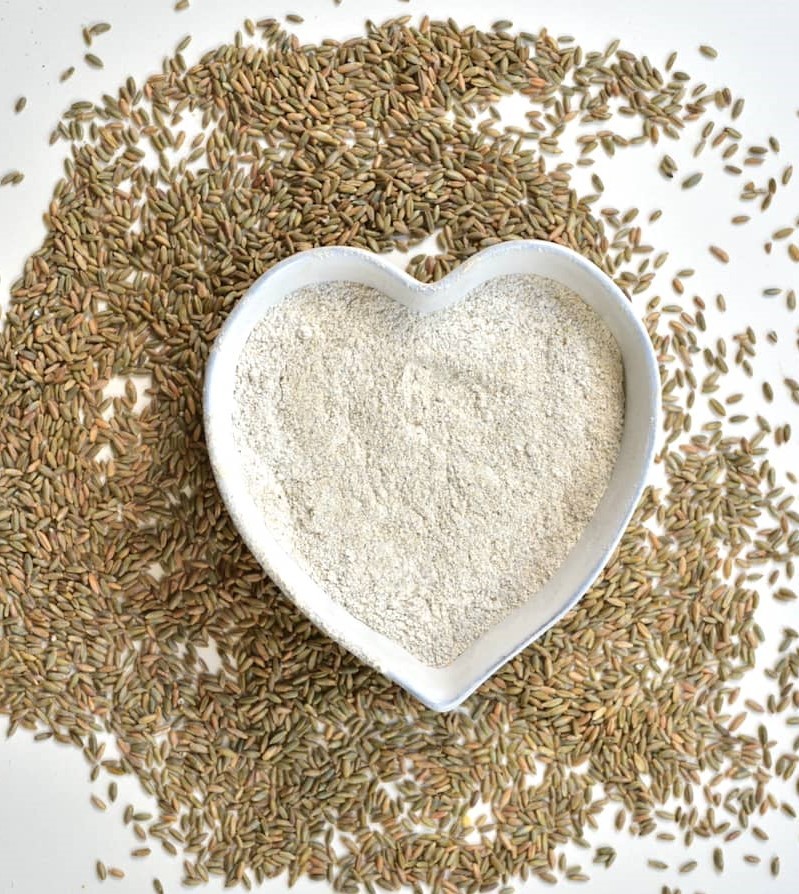
3.2 Flours from gluten-free grains
Pseudo-grain flours, being complete protein and very nutritious, are amaranth and buckwheat, both with an earthy nuttiness, and the expensive quinoa having a grassy flavour with a bitter edge which can be toned down by toasting the grains before grinding. A study revealed when these pseudo-grain flours were individually combined with rice flour to make bread, they resulted in enhanced crumb softness, appearance, colour, odour, texture, flavour, and overall liking. The acceptable proportion of rice turned out to be 40% with amaranth, 15% with buckwheat, and 18% with quinoa.19-23
Rice flour has all the qualities of wheat flour, brown being more nutritious, and can be a good substitute for all-purpose flour. Baking powder may be needed for baking with rice flour.24
Corn flour is one of the best flours to include in the diet, especially in winters. In moderation, it is a good source of energy and nutrients with digestive health benefits.25
Millet flours are highly nutritious and fibre-rich, having all the nutrients of whole grains.26
Oat flour is considered wholesome, healthy, and a great source of antioxidants, excellent for heart.26
3.3 Flours from nuts
In general nut flours have lower GI, with plenty of fibre, healthy fat, protein, and vitamins and can help control blood sugar.
Almond flour is most popular and common nut flour, it is ground-up almonds after blanching and peeling, with all the benefits of original almond intact. It is better than almond meal made by grinding whole unpeeled almonds. Normally available almonds are safe to eat; occasionally they may include a bitter almond, which contains amygdalin (vitamin B17) and this can release a cyanogenic toxin when eaten. However, when soaked for 12 hours, this toxin comes out to the surface, so it is best to soak and peel the almonds. There are also varied opinions on the benefit or otherwise of vitamin B17 in limited dosage in strengthening immune system and treatment of certain cancers.27-31
Walnut flour, although made from kernels from which oil has been extracted, is still rich in omega-3, protein, and fibre. Healthiest of all flours but very costly, it can be mixed with almond flour or wheat flour.32
Other nutritious nut flours are cashew flour rich in copper and flours of sweet chestnut, macadamia, pistachio, hazelnuts, acorns, and the less common pecan with a unique flavour.33-37
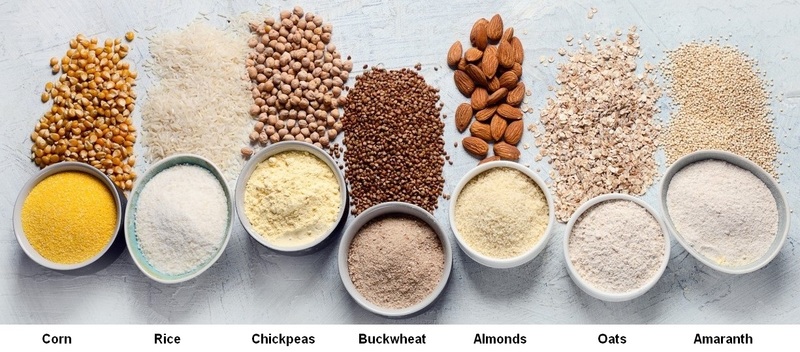
3.4 Flours from seeds
Brazil nut (actually a seed) is the highest natural source of mineral selenium needed for thyroid gland function, it prevents cognitive decline; selenium overdose can be toxic. Other highly nutritious flours are of pumpkin, sesame, sunflower, hemp, flax, and chia seeds.38-42
3.5 Flours from legumes
Legume flours are from common pulses and beans like chickpeas, green and black gram, green and yellow pea, lentils, white bean, soybean, lupin, and peanuts. These are rich in complex carbohydrates, protein, fibre and micronutrients and are an excellent alternative to processed, refined, or all-purpose flours.43-48
3.6 Flours from roots and tubers
Arrowroot is very fine flour made from several different tropical root plants; it has a long shelf life and is commonly used for thickening sauces. High on carbs and low in nutrients, it is easier to digest. Its starch content and prebiotics benefit gut health, control diarrhoea, and help in immunity building.49,50
Tapioca (Sabu dana) is starch extract from cassava root and sold as flour, flakes, or pearls. Full of carbs, it has less nutrients but is a good source of energy in a restricted diet especially during convalescence or stomach upset. It is also used to starch clothes. Cassava flour is made from the entire cassava root, less processed and is more of a whole food with higher vitamin C content than tapioca.51,52
Tiger nut is a tuber, rich in several minerals, vitamin C, D, & E, healthy fats and fibre and high in starch. It can work as a prebiotic and control blood sugar.53,54
3.7 Flour from fruit
Coconut (actually a fruit) flour is a fine powdery flour made from dehydrated coconut flesh after extracting milk from coconut, apt for people with nut allergy. It is a rich source of minerals, exceptionally high on fibre and healthy monounsaturated fatty acids low in omega 6. It has a distinct flavour and mild sweetness. Drier than other low carb flours, it is expensive but can be easily made at home. It may cause gastrointestinal or respiratory symptoms in people intolerant to salicylate present in it.55,56
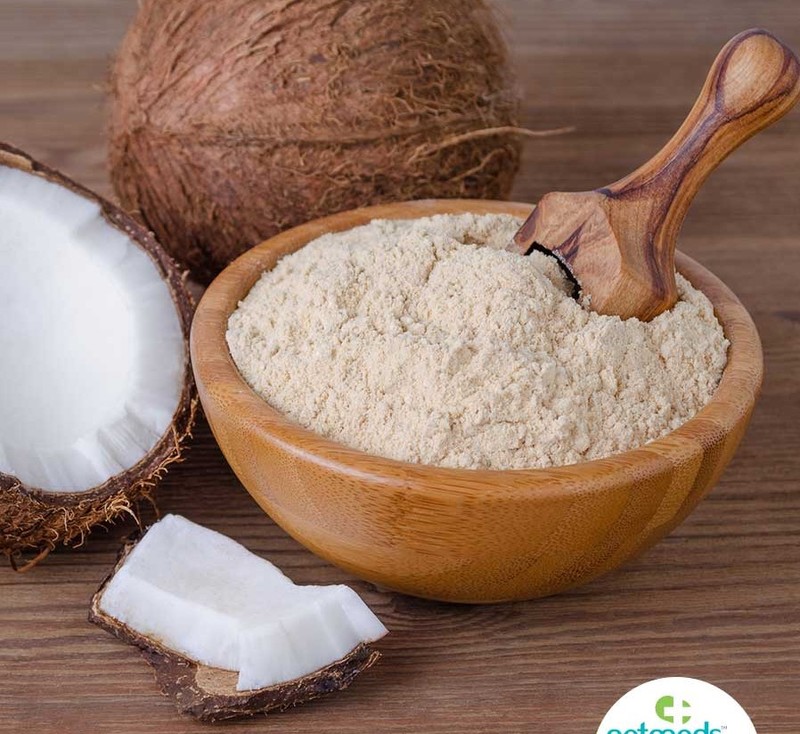
4. Tips for getting the best out of Flours
4.1 Choose flours wisely for a balanced diet appropriate for you - gluten free, low carb, fibre rich, or protein rich. If a label does not say gluten-free, it is likely to have gluten.4-10
4.2 While counting total carbs intake, keep in mind the portion sizes. Thumb rule is calories consumed should equal calories burnt; eat fewer calories to lose weight.5-8
4.3 To make flours at home, it is good to soak grains and nuts 4-8 hours before drying and grinding. This helps to remove antinutrients (lectins and tannins) which affect the digestive system and phytates which hinder mineral absorption. If making nut flour, blend just for a few seconds to prevent it from becoming creamy.57-61
4.4 For better sugar control, eat less flour-based products like bread, rice, cakes, pasta, etc. If you must, opt for low GI flours or mix with flours high in fat and fibre.
4.5 Most flours last 3 to 6 months in air tight containers, longer if refrigerated and up to two years in a freezer. Allow frozen flour to thaw to room temperature and stir it well before using. Do not combine new flour with old flour. Whole wheat and organic flours have a shorter shelf life than others. Avoid exposure to air, light, and moisture.15,62
References and Links
- Sathya Sai Speaks, Divine Discourse 22 Oct 2005, vol 38 chapter 17, “Cultivate satvic qualities right from Childhood” sss38.pdf (sathyasai.org); sss38-17.pdf (sssbpt.info)
- Austin O’Malley: Source: 20 Healthy Flours from Lowest to Highest Carbohydrates - TheDiabetesCouncil.com
- Calories per day: How Many Calories Should You Eat In A Day? – Cleveland Clinic
- Daily Diet Composition Charts for Carbs, Protein, and Fat (verywellfit.com)
- Carbohydrates: How carbs fit into a healthy diet - Mayo Clinic
- 20 Healthy Flours from Lowest to Highest Carbohydrates - TheDiabetesCouncil.com
- A good guide to good carbs: The glycaemic index - Harvard Health
- Glycaemic Index Chart for Common Foods (verywellhealth.com)
- Gluten: Gluten | The Nutrition Source | Harvard T.H. Chan School of Public Health
- What Is Gluten and What Does It Do? | Johns Hopkins Medicine
- Bran: Bran Benefits and Different Types to Try (verywellhealth.com)
- Bran Fact and Types (healthbenefitstimes.com)
- Wheat Bran: Nutrition, Benefits and More (healthline.com)
- Wheat flour: A Guide to Different Types of Wheat Flour (thespruceeats.com)
- All-Purpose Flour Nutrition Facts and Health Benefits (verywellfit.com)
- Whole wheat flour: A beginner’s guide to gluten | King Arthur Baking;
- Is Barley Gluten-Free? (healthline.com)
- Rye flour: How Much Gluten In Rye Flour – TheWellFloured Kitchen
- Pseudo-grain flours: Amaranth Flour Nutrition Facts and Health Benefits (verywellfit.com)
- What’s A Good Amaranth Flour Substitute? - SPICEography
- Ultimate Guide To Buckwheat Flour - From The Larder
- The Pros And Cons Of Quinoa Flour – Healing Plant Foods
- Study: Defining Amaranth, Buckwheat and Quinoa Flour Levels in Gluten-Free Bread: A Simultaneous Improvement on Physical Properties, Acceptability and Nutrient Composition through Mixture Design - PubMed (nih.gov)
- Rice flour: Rice flour and its benefits (indiatimes.com)
- Corn flour: https://www.healthifyme.com/blog/corn-flour-benefits-precautions-and-more/
- Millets, Oats: Vibrionics Newsletter, Health article; https://news.vibrionics.org/en/articles/353
- Nut flours: Almond Flour Benefits, Nutrition Facts and Recipes - Dr Axe (draxe.com)
- Almond Meal vs. Almond Flour: What's the Difference? (healthline.com)
- Are Almonds Poisonous? Different Varieties Explained (healthline.com)
- How Almonds Went From Deadly To Delicious : The Salt : NPR
- Amygdalin: Can Vitamin B-17 Really Kill Cancer? - LifeHack
- Walnut Flour: The Truly European Nut Flour - SPICEography
- 10 of the Best Low Carb Flours (and How To Use Them) (nutritionadvance.com)
- Should You Soak Cashews Before Roasting? - Beyond (beyondthenut.com)
- Chestnut flour: Make Your Own Chestnut Flour From Whole Chestnuts (thespruceeats.com)
- What Is Chestnut Flour and What Can You Make With It? | Taste of Home
- Pecan flour: Pecan Flour vs All-Purpose Flour: The Ultimate Verdict - The Coconut Mama
- Seed flours: 7 Proven Health Benefits of Brazil Nuts - Ben's Natural Health (bensnaturalhealth.com)
- Wholesale Brazil Nut Flour 100% Organic from the amazon rain forest para-food.com
- Pumpkin seed flour: Pumpkin Seed Flour: Unveiling the Nutritional Powerhouse - cookindocs.com
- What Is Sesame Flour? (What It's For, Uses, Substitutes + More) (clockworklemon.com)
- Chia Flour | Baking Ingredients | BAKERpedia
- Legume flours: Legume flours: varieties and benefits (steptohealth.com)
- Chickpea flour: Chickpea Flour Benefits, Uses and Side Effects - Dr Axe (draxe.com)
- Peanut flour: What is Peanut Flour? - The Coconut Mama
- How to Make Peanut Butter: 15 Steps (with Pictures) - wikiHow
- Soy flour: Soy Flour Facts, Health Benefits and Nutritional Value (healthbenefitstimes.com)
- What Is Mung Bean Flour? - The Coconut Mama
- Root flours: Arrowroot: Nutrition, Benefits, and Uses (healthline.com)
- Arrowroot Flour Nutrition Facts and Health Benefits (verywellfit.com)
- What Is Tapioca and What Is It Good For? (healthline.com)
- Tapioca Flour: What Is It? Benefits, Uses and Side Effects - Dr. Axe (draxe.com)
- Tiger nut flour: 9 Health Benefits of Tiger Nuts – Cleveland Clinic
- Tiger Nuts: Benefits, Nutrition and How to Eat - Dr Axe (draxe.com)
- Coconut flour: https://www.nutritionadvance.com/coconut-flour-nutrition-benefits/
- Coconut Flour Nutrition, Benefits and How to Use It - Dr Axe (draxe.com)
- Tips: Activated Nuts: How to Soak Away Hidden Anti-Nutrients | Health (paleohacks.com)
- 12 Nuts You Should Soak Before Eating And Their Soaking Duration (healthyfoodhouse.com)
- https://www.wikihow.com/Soak-Nuts#
- How To Make Nut Flours [Almond, Hazelnut, Cashew] - The Healthy Maven
- The Ultimate Guide To Nut Flours - From The Larder
- Storage of flour: Can You Freeze Flour? (A Guide to Long Term Storage) – Easy Freezing
2. First Sai Vibrionics AP & Telangana State conference, Visakhapatnam 22 July 2023
Attended by 21 practitioners and over 50 devotees, the conference started with usual prayers and welcome address by the conference chair Practitioner11567 and a keynote address by Director of Education10375 who later also gave a presentation on seva opportunities in vibrionics, emphasizing the importance of administrative support needed in Vibrionics Institute and of reaching out to remote areas to serve the poor and the needy.
AP and Telangana regional coordinator11585 presented the annual report on Sai Vibrionics medical camps and clinics conducted in these states. This was followed by a speech by the National coordinator11573 on how to take vibrionics forward. Practitioner11567 touched upon how vibrionics can be integrated with concepts of allopathy, Chinese medicine, ayurvedic body type, pranic healing etc. He emphasized the importance of research and how potentising can be explored to deal with ailments like diabetes, hypertension, allergies and addictions.
Practitioner03560 threw light on the concept of vibrations, frequency, energy, electromagnetic waves and their effect on health; he went on to expound how an individual’s vibrational energy can be raised through deep & controlled breathing, meditation, gratitude, generosity, diet, being close with nature and healthy relationships.
The afternoon session opened with Dr Jit Aggarwal’s short address to the delegates and he inspired the participants with how gratitude in daily life plays a role in our spirituality and wellbeing. He related a wonderful anecdote on how a young woman suffering from cancer had miraculously healed herself through practising forgiveness and gratitude. Practitioner02696 explained how to interact with patients, how we can learn from them and how to keep love as the most important quality in us; he emphasized the importance of self-analysis in healing ourselves as well as others.
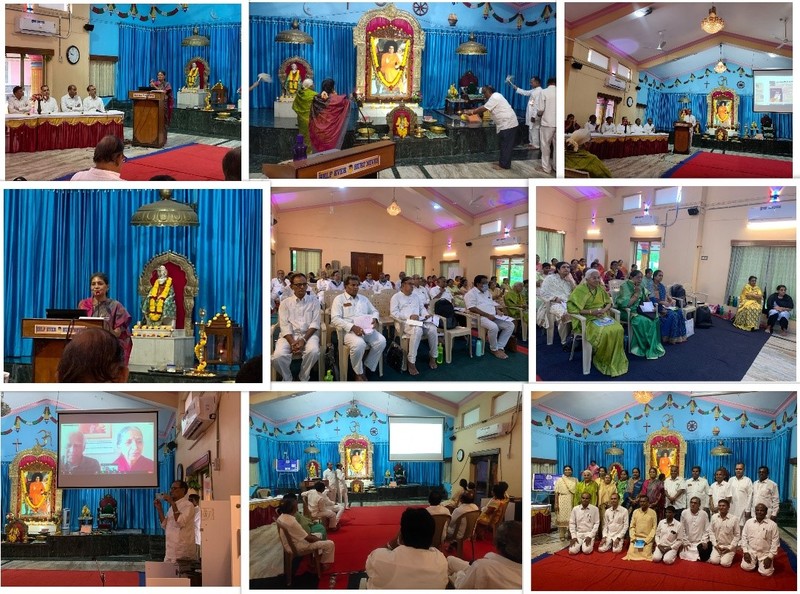
Three AP & Telangana Practitioners11632, 11604, 11618 presented the case histories selected in the case history writing competition, conducted prior to the conference. Practitioner11594 had prepared a poster on the importance of research in vibrionics, in her absence this was presented by the conference chair.
In the final session, practitioners from AP & Telangana participated in a quiz. Prizes were distributed to the winners of the quiz and of the case history writing competition. The conference concluded with vote of thanks, especially to the local Sai Samiti for their wonderful hospitality and aarti to Swami.
It was evident from the feedback collected from the participants that they much appreciated the academic sessions and felt the need for having such conferences on a regular basis.

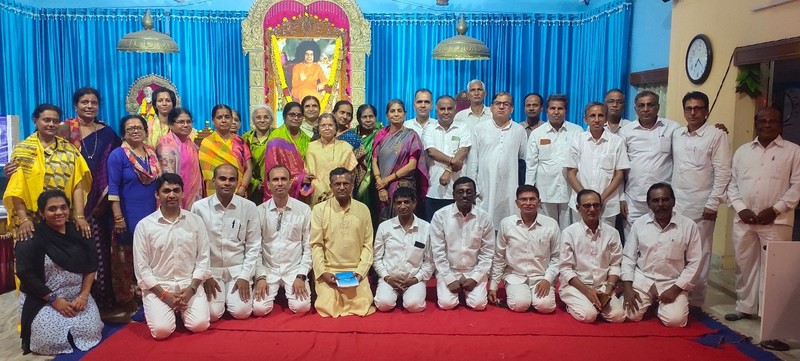
3. Inauguration of Sai Vibrionics Wellness Camp at Araku Valley, Andhra Pradesh, India 23 July 2023
Next day, after the AP & T State conference on 22 July, most of the practitioners made a five-hour bus journey to the popular hill station Araku Valley to inaugurate a Sai Vibrionics Wellness Camp. About 111 kms away from Visakhapatnam, this place is known for its many small tribal communities and coffee plantations.
The remote village of Kothavalasa was selected to provide Sai Vibrionics services to the underserved and isolated population residing in over 50 small villages, and to cater to their pressing healthcare needs. It was a collaborative effort that involved support from vibrionics team, social workers, NGOs, local youth and other volunteers. Local leaders and representatives from the partnering organisations addressed the gathering, emphasizing the significance of the wellness camp and expressed their commitment to support the community's healthcare needs on a regular basis. The importance of maintaining good health and adopting healthier lifestyles was highlighted. The event sought to build trust and rapport between the vibrionics team and the tribal community, ensuring that individuals felt comfortable in taking vibrionics remedies which were new to them all. They were addressed in their local language by Practitioners11567,02696,11585. After the inauguration, a brief meeting with a select group of educated youth was held to give them a more detailed insight into vibrionics. One social worker who regularly guides them on their health issues, farming etc expressed her keen interest in serving the people with this healing system. The program ended with a question-answer session and distribution of 150 IBs and 100 remedy bottles with CC9.3 Tropical diseases for use as prophylactic. With the concurrence of local representatives, it was decided to hold a regular camp on 4th Sunday of each month*. Following the camp, the participants made a fun trip to a ‘Coffee Museum’ and a ‘Tribal Museum’ in the Valley.
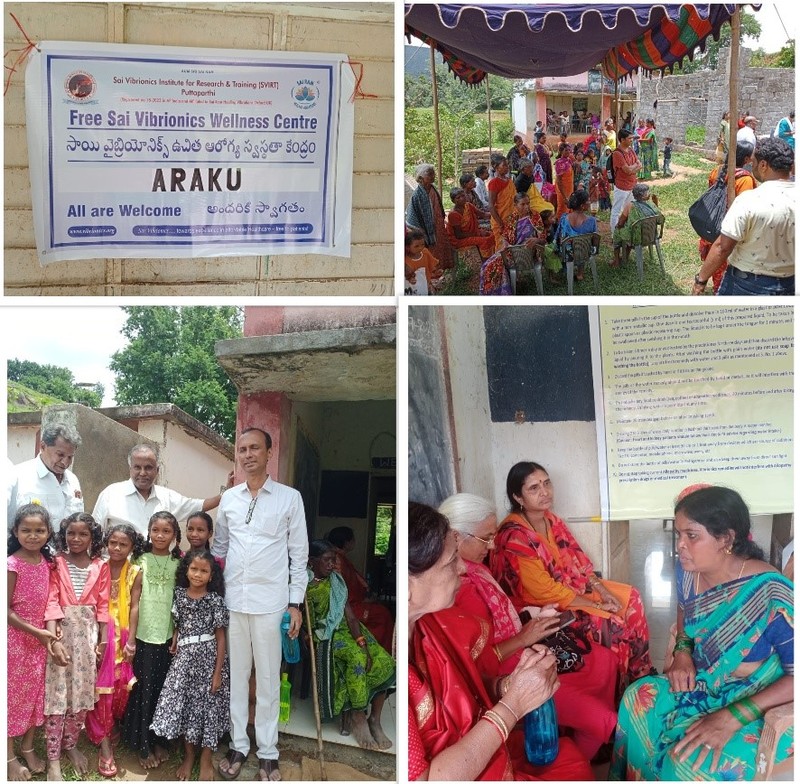
*The first monthly camp was conducted on 27 Aug 2023, by Practitioners 11634, 11648…India and 47 patients from that area were given vibrionics remedies for skin-related problems, cold and cough, fever, and joint pains.
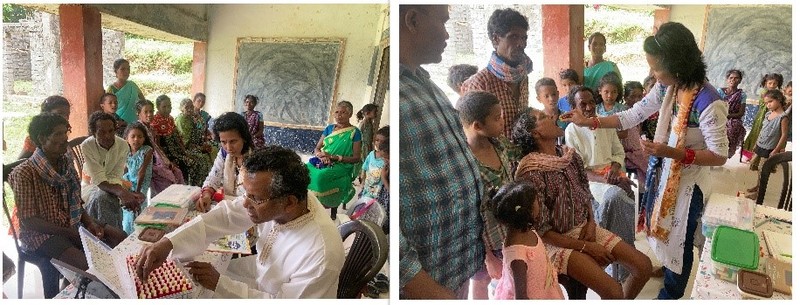
4. In Memoriam
Sri Nandan Singh Bhakuni 11462…India from Faridabad left for his heavenly abode at the age of 74 on 13 July 2023. He started practising Vibrionics in March 2011 after retiring as a senior central government official. A very humble, down-to-earth person, an accomplished bhajan singer, he was ever ready to serve at every opportunity. He had been a Samiti convenor and later district medical seva coordinator in SSSSO, going to Prashanti for seva twice a year. He actively participated in all meetings and other activities of both SSSSO & Vibrionics, sharing his valuable suggestions and experiences despite his failing health. The family’s involvement in Sai activities continues, his wife is a Balvikas guru and his grandchildren are Balvikas students.
